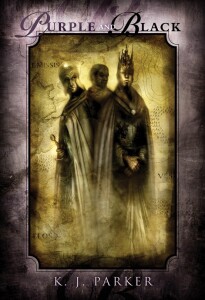 Matthew Winslow wrote this review.
Matthew Winslow wrote this review.
The scenario behind K.J. Parker’s novella Purple & Black should be familiar to anyone who has studied the history of the later Roman Empire. The land of Vesani has had seventy-seven emperors in the past one hundred years: the life expectancy of an emperor is quite short. The latest ruling dynasty has all but eliminated itself in an orgy of destruction. The only member left is Nicephorus, the third son of the emperor, who never expected to be called upon to wear the crown and was quite content being a scholar. His brothers and father, however, do not appear to have taken his wishes into consideration when they took each other to the sword. And so Nicephorus is on an unstable throne and has to try to quell various rebellions.
One such rebellion is fomenting in the northern state of Upper Tremissis, so Nicephorus appoints one of the few people he can trust, his fellow scholar Phormio, whose military prowess amounts to his ability to open a military manual and find his answers there. Phormio’s mission is to quell the insurrection and bring peace to Upper Tremissis as its governor. The letters between Phormio and Nicephorus as the former carries out his mission are the substance of this epistolary novella.
There’s not much more that can be said about the plot without revealing twists in this short (only a little more than 100 pages) novella. But that shortness is also the main problem I had with Purple & Black: There is too much going on in the plot to make the twists unexpected. Even a superficial reader can see what is coming, and so the time that Parker spends developing the background story via the letters is mostly wasted. Since the substance here is a series of letters, background has to be put in via seemingly throwaway comments instead of infodumps. (Who, after all, writes about background to a friend who is already intimate with it?) Parker does that very skillfully, but the shortness proves its downfall. Were this a novel of much greater length, the epistolary format would have worked wonderfully at gradually revealing plot as well as character. As it stands, though, too much characterization is lost because the letters are focused more on the mechanics of the story unfolding. When the characters confront their final fates, the reader is left feeling cold because these are men whom one has never gotten to like, let alone love. There was too much plot here for a novella (but, oddly enough, not enough for a novel).
Parker’s three trilogies and stand-alone novel reveal an author with much skill at plotting, but the short form is still a place where Parker has room to grow.
(Subterranean Press, 2009)
